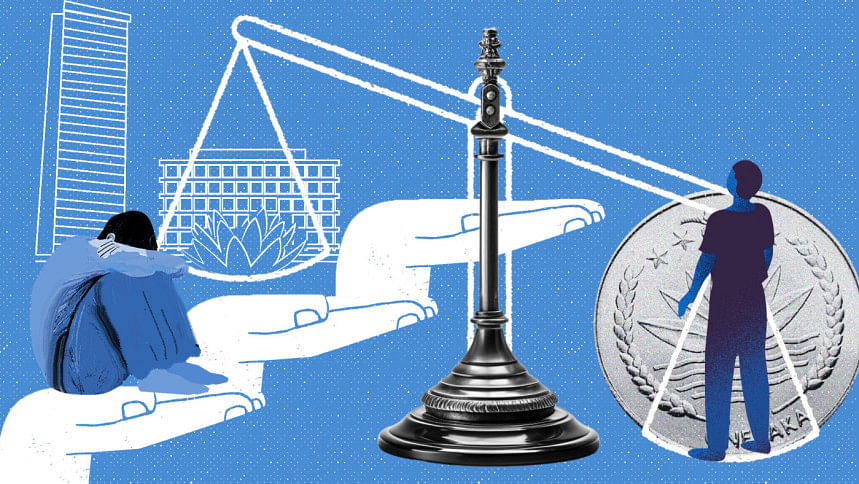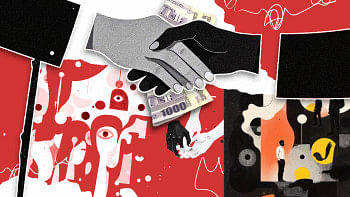Banks should open their doors to the urban poor

"Financial inclusion" has been a buzzword in Bangladesh for many years. As most people in the country, primarily the poor, do not have bank accounts, this term has been used to justify the increase in the number of financial institutions here, especially banks. Some shrewd oligarchs became successful in getting a licence to open banks by persuading the authorities that financial inclusion is necessary for attaining rapid economic growth. It was argued that a large number of banks would increase formal finance and lessen the impact of exploitative informal credit markets, which are non-institutional and unregulated ways of extending credit mainly by various income groups including moneylenders.
Informal credit markets prevail in an economy because banks cannot reach all potential customers, especially the poor, mainly due to a mismatch between demand for and supply of financial services. In Bangladesh, the rural poor have easy access to microfinance institutions, which mostly work in rural areas. However, the urban poor have less access to finance since the number of microfinance institutions in urban areas is very low. Surprisingly, banks cannot serve the urban poor either. Consequently, many urban poor depend on informal finance to reduce their liquidity constraint.
There are a number of practical reasons why people access informal credit markets. These markets grant loans without any physical collateral. A borrower does not need to make any periodical savings; rules and regulations are not rigid; there is flexibility in loan size and instalment repayment; and at times, the borrower does not even need to mention the purpose of a loan. Moreover, informal loans are sometimes a matter of verbal agreement without a formal contract; borrowers do not need to produce paper documents and fill out an application form, and loan disbursement is done very quickly. All these factors make informal credits easy for the poor.
The advantage of informal finance is strongly supported by an empirical research that I conducted in 2023 on 400 poor people in Dhaka city to explore their financial behaviour. In the research, 24 percent of the respondents took loans from moneylenders, 13 percent from local income groups, five percent from goldsmiths, and seven percent from dadon loan suppliers, which is a loan in cash for crop production or product manufacturing, to be repaid in the form of produce with its price predetermined generally at a lower rate than the normal market price. Other poor respondents borrowed from their relatives (20 percent), neighbours and friends (28 percent).
It was also found that nearly 70 percent of the loans were granted without collateral. In these credit markets, collateral is required when a loan size is large, the borrower is perceived to be risky and has no third-party guarantee. The research notably identified that about 51 percent of respondents borrowed from informal credit markets because they found it easy. While quick funding attracted 19 percent of borrowers, no collateral requirement drew in 14 percent of borrowers. Less paperwork and the unavailability of formal credit encouraged seven percent and six percent of borrowers, respectively.
The average size of the loan was Tk 25,580. The interest rate ranged between zero and 250 percent with the average of 24 percent. About 45 percent of borrowers took loans from their affluent relatives, well-off neighbours, and generous friends at minimum interest rates. It was identified that informal loans were taken for both productive (income-generating) and unproductive (consumption) purposes. Nearly 56 percent of the loans were taken for consumption, which is quite normal because formal credit markets do not extend loans for such purpose.
About 30 percent of the borrowers were found to have defaulted on loans. The main reason for default was high household expense (38 percent), followed by loss in business (30 percent), accidental cost (29 percent), and lack of financial discipline (three percent). The most dominating consequence of loan default was harassment—verbal abuse, physical assault, threat in the public and others—by the lender (71 percent), followed by absconding (14 percent) of borrowers, and loss of collateral (11 percent).
Our banks are also less eager to provide financial services to the poor. When a bank perceives that potential customers are not good suppliers of deposits, it discourages them from opening accounts. The overall environment of a bank branch is uncomfortable for the poor as well. Many of our so-called smart bankers are also less interested in conversing with poor customers. They deal with poor customers only when they are bound to do so by the Bangladesh Bank.
Informal finance has been found to be exceedingly exploitative. It is almost impossible to use informal credit profitably at abnormally high interest rates. Borrowers frequently default and lose their valuable collateral, which aggravates their poverty. There are also other humiliating consequences of loan default. Hence, it is necessary to take these people out of informal credit markets.
However, our formal financial institutions, principally banks, largely fail to reach the poor. Banks tend to produce large loans that the poor hardly need. Their loans require collateral that the poor generally lack. In banks, a person has to fill out a long account opening form; their loan application form is even longer; they need many other documents too. A borrower has to visit a bank several times for a loan. To the poor, every visit has a high opportunity cost—the cost of not being able to work during the visit, for example. All these factors make the lending process complex for them, and banks fail to meet the urban poor's financial needs.
Our banks are also less eager to provide financial services to the poor. When a bank perceives that potential customers are not good suppliers of deposits, it discourages them from opening accounts. The overall environment of a bank branch is uncomfortable for the poor as well. Many of our so-called smart bankers are also less interested in conversing with poor customers. They deal with poor customers only when they are bound to do so by the Bangladesh Bank. For instance, private banks are less involved in granting agriculture loans. They fill the quota of this loan because it is a requirement set by the central bank.
The number of banks in Bangladesh stands at 62 now. But 53 percent of the population, mainly the poor, do not have bank accounts. It is impossible to attain real development while keeping this large number of people outside the banking network. These unbanked people must be integrated into the formal financial channels. Banks must be proactive and help reduce the prevalence of informal credit because the sizeable presence of informal finance indicates a big failure of formal finance.
Dr Md Main Uddin is professor and former chairman in the Department of Banking and Insurance at the University of Dhaka. He can be reached at [email protected].
Views expressed in this article are the authors' own.
Follow The Daily Star Opinion on Facebook for the latest opinions, commentaries and analyses by experts and professionals. To contribute your article or letter to The Daily Star Opinion, see our guidelines for submission.

 For all latest news, follow The Daily Star's Google News channel.
For all latest news, follow The Daily Star's Google News channel. 










Comments